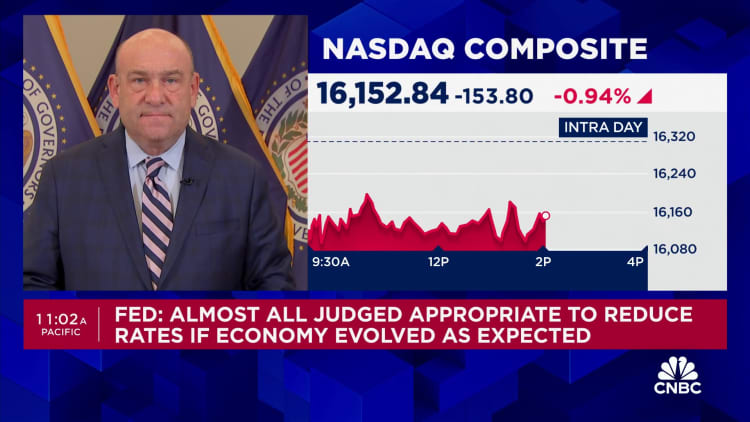[ad_1]

Federal Reserve officers at their March assembly expressed concern that inflation wasn’t shifting decrease rapidly sufficient, although they nonetheless anticipated to chop rates of interest in some unspecified time in the future this yr.
At a gathering by which the Federal Open Market Committee once more voted to carry short-term borrowing charges regular, policymakers additionally confirmed misgivings that inflation, whereas easing, wasn’t doing so in a convincing sufficient trend. The Fed at present targets its benchmark charge between 5.25%-5.5%
As such, FOMC members voted to maintain language within the post-meeting assertion that they would not be slicing charges till they “gained higher confidence” that inflation was on a gradual path again to the central financial institution’s 2% annual goal.
“Contributors usually famous their uncertainty concerning the persistence of excessive inflation and expressed the view that current knowledge had not elevated their confidence that inflation was shifting sustainably right down to 2 %,” the minutes stated.
In what apparently was a prolonged dialogue about inflation on the assembly, officers stated geopolitical turmoil and rising vitality costs stay dangers that would push inflation larger. Additionally they cited the potential that looser coverage may add to cost pressures.
On the draw back, they cited a extra balanced labor market, enhanced expertise together with financial weak point in China and a deteriorating industrial actual property market.
U.S. Federal Reserve Chair Jerome Powell holds a press convention following a two-day assembly of the Federal Open Market Committee on rate of interest coverage in Washington, U.S., March 20, 2024.
Elizabeth Frantz | Reuters
Additionally they mentioned higher-than-expected inflation readings in January and February. Chair Jerome Powell stated it is potential the 2 months’ readings have been brought on by seasonal points, although he added it is arduous to inform at this level. There have been members on the assembly who disagreed.
“Some individuals famous that the current will increase in inflation had been comparatively broad primarily based and subsequently shouldn’t be discounted as merely statistical aberrations,” the minutes said.
That a part of the dialogue was partly related contemplating the discharge got here the identical day that the Fed obtained extra dangerous information on inflation.
CPI validates their concern
The client value index, a well-liked inflation gauge although not the one the Fed most intently focuses on, confirmed a 12-month charge of three.5% in March. That was each above market expectations and represented a rise of 0.3 share level from February, giving rise to the concept that sizzling readings to start out the yr might not have been an aberration.
Following the CPI launch, merchants within the fed funds futures market recalibrated their expectations. Market pricing now implies the primary charge reduce to come back in September, for a complete of simply two this yr. Earlier to the discharge, the percentages have been in favor of the primary discount coming in June, with three complete, in keeping with the “dot plot” projections launched after the March assembly.
The dialogue on the assembly indicated that “nearly all individuals judged that it could be acceptable to maneuver coverage to a much less restrictive stance in some unspecified time in the future this yr if the economic system advanced broadly as they anticipated,” the minutes stated. “In help of this view, they famous that the disinflation course of was persevering with alongside a path that was usually anticipated to be considerably uneven.”
In different motion on the assembly, officers mentioned the opportunity of ending the steadiness sheet discount. The Fed has shaved about $1.5 trillion off its holdings of Treasurys and mortgage-backed securities by permitting as much as $95 billion in proceeds from maturing bonds to roll off every month fairly than reinvesting them.
There have been no choices made or indications about how the easing of what has grow to be generally known as “quantitative tightening” will occur, although the minutes stated the roll-off can be reduce by “roughly half” from its present tempo and the method ought to begin “pretty quickly.” Most market economists count on the method to start within the subsequent month or two.
The minutes famous that members imagine a “cautious” method must be taken.
[ad_2]




